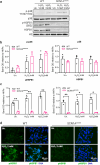Ascorbic acid mitigates the impact of oxidative stress in a human model of febrile seizure and mesial temporal lobe epilepsy
- PMID: 38467734
- PMCID: PMC10928078
- DOI: 10.1038/s41598-024-56680-4
Ascorbic acid mitigates the impact of oxidative stress in a human model of febrile seizure and mesial temporal lobe epilepsy
Abstract
Prolonged febrile seizures (FS) in children are linked to the development of temporal lobe epilepsy (MTLE). The association between these two pathologies may be ascribed to the long-term effects that FS exert on neural stem cells, negatively affecting the generation of new neurons. Among the insults associated with FS, oxidative stress is noteworthy. Here, we investigated the consequences of exposure to hydrogen peroxide (H2O2) in an induced pluripotent stem cell-derived neural stem cells (iNSCs) model of a patient affected by FS and MTLE. In our study, we compare the findings from the MTLE patient with those derived from iNSCs of a sibling exhibiting a milder phenotype defined only by FS, as well as a healthy individual. In response to H2O2 treatment, iNSCs derived from MTLE patients demonstrated an elevated production of reactive oxygen species and increased apoptosis, despite the higher expression levels of antioxidant genes and proteins compared to other cell lines analysed. Among the potential causative mechanisms of enhanced vulnerability of MTLE patient iNSCs to oxidative stress, we found that these cells express low levels of the heat shock protein HSPB1 and of the autophagy adaptor SQSTM1/p62. Pre-treatment of diseased iNSCs with the antioxidant molecule ascorbic acid restored HSBP1 and p62 expression and simultaneously reduced the levels of ROS and apoptosis. Our findings suggest the potential for rescuing the impaired oxidative stress response in diseased iNSCs through antioxidant treatment, offering a promising mechanism to prevent FS degeneration in MTLE.
© 2024. The Author(s).
Conflict of interest statement
The authors declare no competing interests.
Figures






Similar articles
-
Hippocampal expression of heat shock proteins in mesial temporal lobe epilepsy with psychiatric comorbidities and their relation to seizure outcome.Epilepsia. 2014 Nov;55(11):1834-43. doi: 10.1111/epi.12787. Epub 2014 Sep 19. Epilepsia. 2014. PMID: 25244257
-
Community structure analysis of transcriptional networks reveals distinct molecular pathways for early- and late-onset temporal lobe epilepsy with childhood febrile seizures.PLoS One. 2015 May 26;10(5):e0128174. doi: 10.1371/journal.pone.0128174. eCollection 2015. PLoS One. 2015. PMID: 26011637 Free PMC article.
-
Functional variant in complement C3 gene promoter and genetic susceptibility to temporal lobe epilepsy and febrile seizures.PLoS One. 2010 Sep 16;5(9):e12740. doi: 10.1371/journal.pone.0012740. PLoS One. 2010. PMID: 20862287 Free PMC article.
-
Febrile seizures and temporal lobe epileptogenesis.Epilepsy Res. 2010 Mar;89(1):27-33. doi: 10.1016/j.eplepsyres.2009.11.002. Epub 2009 Dec 11. Epilepsy Res. 2010. PMID: 20005077 Review.
-
Febrile seizures and mesial temporal sclerosis.Curr Opin Neurol. 2004 Apr;17(2):161-4. doi: 10.1097/00019052-200404000-00013. Curr Opin Neurol. 2004. PMID: 15021243 Review.
Cited by
-
From the different pathogenesis of epileptogenesis: vitamins as an adjunctive treatment for epilepsy.Acta Epileptol. 2025 Jul 9;7(1):38. doi: 10.1186/s42494-025-00228-0. Acta Epileptol. 2025. PMID: 40629476 Free PMC article. Review.
-
Evaluating the impact of gut microbiota, circulating cytokines and plasma metabolites on febrile seizure risk in Mendelian randomization study.Sci Rep. 2025 Apr 19;15(1):13603. doi: 10.1038/s41598-025-97759-w. Sci Rep. 2025. PMID: 40253491 Free PMC article.
References
-
- Parent JM, Yu TW, Leibowitz RT, Geschwind DH, Sloviter RS, Lowenstein DH. Dentate granule cell neurogenesis is increased by seizures and contributes to aberrant network reorganization in the adult rat hippocampus. J. Neurosci. 1997;17:3727–3738. doi: 10.1523/JNEUROSCI.17-10-03727.1997. - DOI - PMC - PubMed
MeSH terms
Substances
Grants and funding
LinkOut - more resources
Full Text Sources
Research Materials
Miscellaneous

